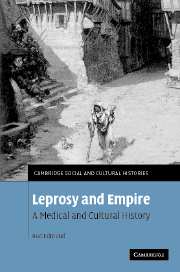Book contents
- Frontmatter
- Contents
- List of illustrations
- Acknowledgements
- Introduction
- 1 Describing, imagining and defining leprosy, 1770–1867
- 2 Scientists discuss the causes of leprosy, and the disease becomes a public issue in Britain and its empire, 1867–1898
- 3 The fear of degeneration: leprosy in the tropics and the metropolis at the fin de siècle
- 4 Segregation in the high imperial era: island leper colonies on Hawaii, at the Cape, in Australia and New Zealand
- 5 Concentrating and isolating racialised others, the diseased and the deviant: the idea of the colony in the later nineteenth and early twentieth centuries
- 6 Writers visiting leper colonies: Charles Warren Stoddard, Robert Louis Stevenson, Jack London, Graham Greene and Paul Theroux
- Postscript
- Index
1 - Describing, imagining and defining leprosy, 1770–1867
Published online by Cambridge University Press: 17 July 2009
- Frontmatter
- Contents
- List of illustrations
- Acknowledgements
- Introduction
- 1 Describing, imagining and defining leprosy, 1770–1867
- 2 Scientists discuss the causes of leprosy, and the disease becomes a public issue in Britain and its empire, 1867–1898
- 3 The fear of degeneration: leprosy in the tropics and the metropolis at the fin de siècle
- 4 Segregation in the high imperial era: island leper colonies on Hawaii, at the Cape, in Australia and New Zealand
- 5 Concentrating and isolating racialised others, the diseased and the deviant: the idea of the colony in the later nineteenth and early twentieth centuries
- 6 Writers visiting leper colonies: Charles Warren Stoddard, Robert Louis Stevenson, Jack London, Graham Greene and Paul Theroux
- Postscript
- Index
Summary
Leprosy in the Pacific and Atlantic worlds
In October 1773 Captain Cook's Resolution was caught in a violent and prolonged storm off the coast of New Zealand. The ship was returning to Cook's safe harbour at Queen Charlotte Sound after a sweep of the southern Pacific that had taken in Tahiti, the Society Islands and several islands in the Tongan group. Among those on board was Johann Reinhold Forster, the German-born scientist on Cook's second voyage (1772–5). On 26 October he recorded in his journal that ‘The Sea is mountainous & the wind rages with the utmost fury.’ Water was coming through the door of his cabin, all the furniture was overturned and Forster could only remain in bed by holding on to the frame with both hands. Two days later the storm had not abated and Forster's discomfort had been compounded by his frustration at the ship's lack of progress: ‘the longer we are out at Sea, the less time is left to us … for our Observations on Plants & Animals’. So he turned to ‘the remarks of Prof. Michaelis on the Leprosy, and its various branches’, and reflected on the different kinds of ‘leprosy’ he had observed on the recent voyage.
In one of the longest single entries anywhere in his journals Forster described the three stages of leprosy he had observed.
- Type
- Chapter
- Information
- Leprosy and EmpireA Medical and Cultural History, pp. 24 - 60Publisher: Cambridge University PressPrint publication year: 2006



